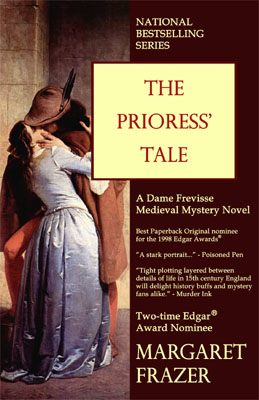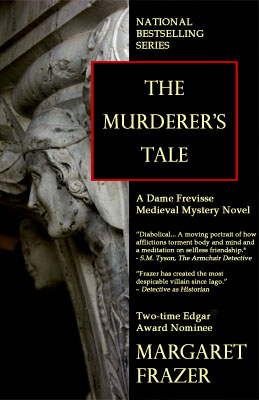 An all-too-common motif in novels purportedly set in medieval England is the ubiquitous presence of violence. According to these novels, medieval England was full of scoff-law lords raiding and raping as they would with nary a law officer to thwart them, and with the only decent people willing to stand out against them The Hero and possibly his favored companions. All other people are merely hapless victims who must endure the lawless times, with one or (preferably) more of them getting killed outright in the first chapter, just to show the reader he’s really in medieval England. This is “medieval on the cheap” – an author using “medieval” as synonymous with “nasty and vicious” because he or she doesn’t want the bother of being accurate about the time, only a setting in which to set scenes of brutality to titillate readers.
An all-too-common motif in novels purportedly set in medieval England is the ubiquitous presence of violence. According to these novels, medieval England was full of scoff-law lords raiding and raping as they would with nary a law officer to thwart them, and with the only decent people willing to stand out against them The Hero and possibly his favored companions. All other people are merely hapless victims who must endure the lawless times, with one or (preferably) more of them getting killed outright in the first chapter, just to show the reader he’s really in medieval England. This is “medieval on the cheap” – an author using “medieval” as synonymous with “nasty and vicious” because he or she doesn’t want the bother of being accurate about the time, only a setting in which to set scenes of brutality to titillate readers.
In writing The Prioress’ Tale, I played very consciously against this cliché. When Domina Alys hears her cousin has killed a man, she wastes no time on handwringing over the wrong he has done or the morality of the matter. Instead, her first thought and her immediate protest are how the man’s murder will bring the sheriff down on them. She knows the law well enough to know no one simply gets away with murder and theft just because he has the power to commit them and an armed force to back him. In the reality of the time, she knows there will be legal consequences and they will likely come quickly. Reynold may not have sense enough to realize it, but other people in the story not only know it – they depend on it.
Admittedly, at certain times and places, law and the structure of society did break down spectacularly. King Stephen’s reign in the 1100s was a disaster of violence and lawlessness. Any book set then cannot avoid dealing with a time so horrible that a chronicler wrote, “Christ and his saints slept” (the title of an excellent, harrowing novel by Sharon Kay Penman, set in that bleakened century). Nor do the Scottish borders seem to have been a good place to find a peaceful life at any time. There were also occasional outbreaks of violent opposition to a king, and feuds, with sometimes a pair of powerful men having an armed go at each other. But these were exceptions, not the day-to-day way of things, because through the centuries people had worked at creating a strong legal structure in English society and making it work. From village level onward to the royal courts themselves, there was a complex of officers great and small charged with keeping the peace and a complicated bureaucracy to support them. Through the medieval centuries in England there was a steady increase in curbing societal violence at all levels, and despite such aberrations as an outbreak of criminal gangs in the northern Midlands around 1300 and occasional lords or powerful commoners who threw their weight around and caused trouble in their area, these affected only limited places and only for limited times.
That is something for anyone looking in detail at medieval English criminal activity and the legal system set up to deal with it to keep in mind, especially while reading scholarly studies, because the same examples of medieval violence tend to be cited over and over. The Folvilles and Coterels gangs, for example, are perennially popular, not least because extensive scholarly study has been done on the legal documents concerning them. (For a fine example: John Bellamy, “The Coterel Gang: an Anatomy of a Band of Fourteenth-century Criminals,” English Historical Review, vol. LXXIX, pp. 698-717, 1964.) But take note that individual examples like this are limited in scope and scattered over a wide number of years. They reveal that there were criminals in medieval England and that they did criminal things, but to extrapolate from these cases that uncurbed violence was a constant in medieval life everywhere and all the time is the equivalent of using the violence in Prohibition-era Chicago to characterize the whole of American society’s behavior through all the centuries. (And, come to it, the violence in Chicago went on far longer than the Coterels and Folvilles ever managed.)
It is perfectly possible – by choosing the right time and place – to write an accurate novel set in medieval England replete to overflowing with violence if that is what the author chooses to dwell on. For Dame Frevisse, however, I deliberately chose a time and place where violence was not a way of life in England – and, not incidentally, the great plague was in abeyance for a while. Depriving myself of these two ever-popular means of instant drama, I’ve been left free to explore other aspects of medieval life and people: Their ordinary days before violence comes out of seeming nowhere making the shock of it the more wrenching – both for them and hopefully for the reader – because it is set against the usual tenor of their world, with afterward their effort set not only to finding out and dealing with the criminal but starting the hard striving toward restoring to their lives their lost balance, to putting together a new peace in place of the one so unreasonably and unexpectedly stolen from them. I find it a very satisfying quest to write of.
– Margaret
















